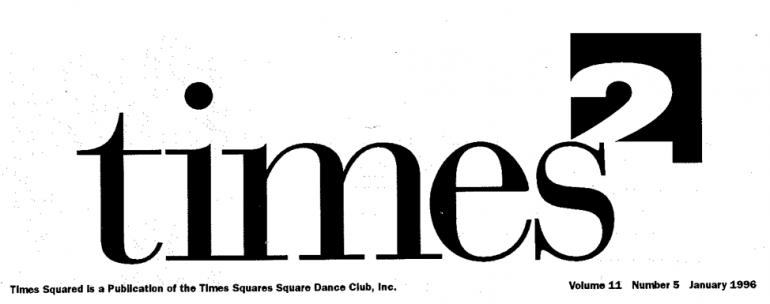Doris Nixon became everyone’s grandmother as she joyously danced with Times Squares. Here, in three parts, is her story.

Before moving to New York City, I was an elementary school teacher in California. The year I retired, my son and daughter-in-law asked me to live with then in Manhattan. They needed someone to stay with their children and watch them during the day.
Square dancing had always taken up all my spare time. I danced every evening of the week and on some Sunday afternoons. I mistakenly thought dancing did not exist in Manhattan. I’d looked everywhere until I read a flyer posted n my church bulletin board. I could barely believe what I had read. A social club in the church I attended announced they were having a square dance on Friday night. I could hardly wait for Friday night to arrive.
To my delight, they had hired a live caller. While the caller set up his equipment, I talked with him. I saw several records in his collection that were familiar to me. From this I gathered he was a caller attuned to the type of dancing I did best.
Once the caller began, a woman asked me to be her partner. Secretly I had hoped one of the men would ask me. The woman who asked me was a good dancer, but nothing beats dancing with a man. There are always so many women at most of the dances I attend.
As I looked around the room at the other squares, I discovered that men were dancing with men and women were dancing with women. I thought this was unusual, but it didn’t yet register. I kept right on dancing, hoping one of the men would ask me.
When I asked Ron the caller, about this, he said he was a teacher, so it was natural for him to teach square dancing. He said most of the dancers were men. Then he invited me to come and dance with his club, called Times Squares, and explained that the club was a lesbian and gay club.
At first, I was taken aback. I had never suspected such a thing existed. When lesbians and gays dance, the disregard gender. The man’s part is called the lead part and the women’s part is called the follow part. Most of them can dance either. This saves a lot of confusion when acquiring a partner. I saw squares with all men and squares with all women dancing together. I also saw squares with about half and half, but none of them were dancing in the traditional positions. One square I danced in was composed of seven women and one man, and he was dancing in the follow position.
Once time when I came back from vacation, after I had been dancing with the club for a while, Dick, another dancer, called me and volunteered to pick me up and take me to a dance. I was happy about that as it is so much easier to have someone drive me to the dance than to go by subway. Dick said his lover, Gene, was going to nursing school and was too busy studying to go dancing. Dick was already a nurse and had inspired Gene. Dick and Gene had been together for twelve years and were prone to brag about it.
At one dance I was surprised to see Ken. He looked great. He was in remission of AIDS. Ken had sparked the creation of the Times Squares dance club. In the beginning, Ken traveled the city on his bike, posting flyers at the Center and in the bars and bookstores. Thirty-five people showed up for the first dance.
When the Times Squares Club first started, they danced in the Times Square area of Manhattan, hence the name. later they moved their dances to a public school near Christopher Street, in the Village.

